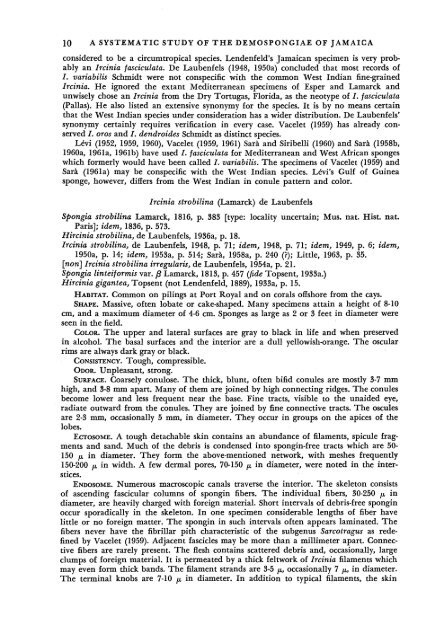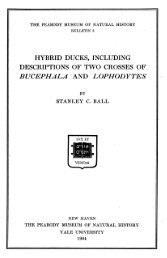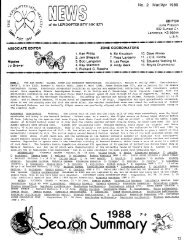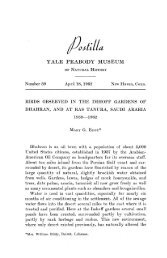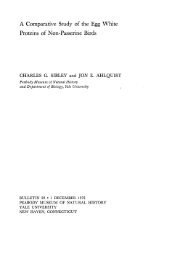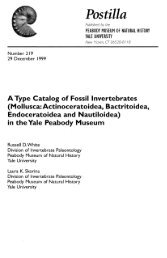Bulletin 20 - Peabody Museum of Natural History - Yale University
Bulletin 20 - Peabody Museum of Natural History - Yale University
Bulletin 20 - Peabody Museum of Natural History - Yale University
Create successful ePaper yourself
Turn your PDF publications into a flip-book with our unique Google optimized e-Paper software.
10 A SYSTEMATIC STUDY OF THE DEMOSPONGIAE OF JAMAICA<br />
considered to be a circumtropical species. Lendenfeld's Jamaican specimen is very probably<br />
an Ircinia fasciculata. De Laubenfels (1948, 1950a) concluded that most records <strong>of</strong><br />
/. variabilis Schmidt were not conspecific with the common West Indian fine-grained<br />
Ircinia. He ignored the extant Mediterranean specimens <strong>of</strong> Esper and Lamarck and<br />
unwisely chose an Ircinia from the Dry Tortugas, Florida, as the neotype <strong>of</strong> /. fasciculata<br />
(Pallas). He also listed an extensive synonymy for the species. It is by no means certain<br />
that the West Indian species under consideration has a wider distribution. De Laubenfels'<br />
synonymy certainly requires verification in every case. Vacelet (1959) has already conserved<br />
/. oros and /. dendroides Schmidt as distinct species.<br />
Levi (1952, 1959, 1960), Vacelet (1959, 1961) Sara and Siribelli (1960) and Sara (1958b,<br />
1960a, 1961a, 1961b) have used /. fasciculata for Mediterranean and West African sponges<br />
which formerly would have been called /. variabilis. The specimens <strong>of</strong> Vacelet (1959) and<br />
Sara (1961a) may be conspecific with the West Indian species. LeVi's Gulf <strong>of</strong> Guinea<br />
sponge, however, differs from the West Indian in conule pattern and color.<br />
Ircinia strobilina (Lamarck) de Laubenfels<br />
Spongia strobilina Lamarck, 1816, p. 383 [type: locality uncertain; Mus. nat. Hist. nat.<br />
Paris]; idem, 1836, p. 573.<br />
Hircinia strobilina, de Laubenfels, 1936a, p. 18.<br />
Ircinia strobilina, de Laubenfels, 1948, p. 71; idem, 1948, p. 71; idem, 1949, p. 6; idem,<br />
1950a, p. 14; idem, 1953a, p. 514; Sara, 1958a, p. 240 (?); Little, 1963, p. 35.<br />
[non] Ircinia strobilina irregularis, de Laubenfels, 1954a, p. 21.<br />
Spongia linteiformis var. ft Lamarck, 1813, p. 457 (fide Topsent, 1933a.)<br />
Hircinia gigantea, Topsent (not Lendenfeld, 1889), 1933a, p. 15.<br />
HABITAT. Common on pilings at Port Royal and on corals <strong>of</strong>fshore from the cays.<br />
SHAPE. Massive, <strong>of</strong>ten lobate or cake-shaped. Many specimens attain a height <strong>of</strong> 8-10<br />
cm, and a maximum diameter <strong>of</strong> 4-6 cm. Sponges as large as 2 or 3 feet in diameter were<br />
seen in the field.<br />
COLOR. The upper and lateral surfaces are gray to black in life and when preserved<br />
in alcohol. The basal surfaces and the interior are a dull yellowish-orange. The oscular<br />
rims are always dark gray or black.<br />
CONSISTENCY. Tough, compressible.<br />
ODOR. Unpleasant, strong.<br />
SURFACE. Coarsely conulose. The thick, blunt, <strong>of</strong>ten bifid conules are mostly 3-7 mm<br />
high, and 3-8 mm apart. Many <strong>of</strong> them are joined by high connecting ridges. The conules<br />
become lower and less frequent near the base. Fine tracts, visible to the unaided eye,<br />
radiate outward from the conules. They are joined by fine connective tracts. The oscules<br />
are 2-3 mm, occasionally 5 mm, in diameter. They occur in groups on the apices <strong>of</strong> the<br />
lobes.<br />
ECTOSOME. A tough detachable skin contains an abundance <strong>of</strong> filaments, spicule fragments<br />
and sand. Much <strong>of</strong> the debris is condensed into spongin-free tracts which are 50-<br />
150 fi in diameter. They form the above-mentioned network, with meshes frequently<br />
150-<strong>20</strong>0 /M in width. A few dermal pores, 70-150 p in diameter, were noted in the interstices.<br />
ENDOSOME. Numerous macroscopic canals traverse the interior. The skeleton consists<br />
<strong>of</strong> ascending fascicular columns <strong>of</strong> spongin fibers. The individual fibers, 30-250 /x in<br />
diameter, are heavily charged with foreign material. Short intervals <strong>of</strong> debris-free spongin<br />
occur sporadically in the skeleton. In one specimen considerable lengths <strong>of</strong> fiber have<br />
little or no foreign matter. The spongin in such intervals <strong>of</strong>ten appears laminated. The<br />
fibers never have the fibrillar pith characteristic <strong>of</strong> the subgenus Sarcotragus as redefined<br />
by Vacelet (1959). Adjacent fascicles may be more than a millimeter apart. Connective<br />
fibers are rarely present. The flesh contains scattered debris and, occasionally, large<br />
clumps <strong>of</strong> foreign material. It is permeated by a thick feltwork <strong>of</strong> Ircinia filaments which<br />
may even form thick bands. The filament strands are 3-5 /x, occasionally 7 /x, in diameter.<br />
The terminal knobs are 7-10 /x in diameter. In addition to typical filaments, the skin


